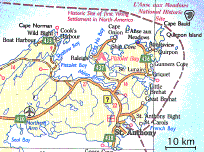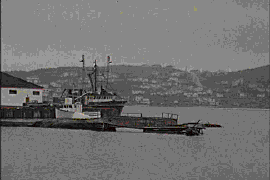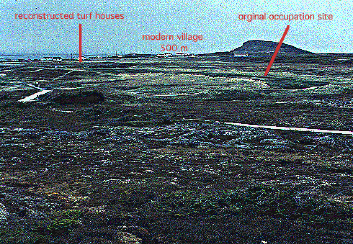

|
As you can see, our final destination is an area that makes a rough triangle, with the airport, St Anthony and L'Anse aux Meadows NHS at the three corners. The single road runs to the rough centre. On the way in, the airport leg (and to the south) is about 30 minutes. The north leg to LAM is also about 30 minutes travel. The last leg to St Anthony is about 20 minutes drive. At the fork there is an information kiosk for the region. So - there you are, after four or five days of travel, and deciding what to do next. This will likely depend on what kind of accommodations you have arranged for. On the south fork to St Anthony, there is basically nothing until you get into town. St Anthony is a regional centre, but in truth it is only a small town, with a total population of 3500. Like most towns in Newfoundland, it is built around a bay - in this case in a long flat cup shape. Right into town, the road forks again, with the right hand side holding the motels, business section and the hospital and eventually Fishing Point. The left hand side is mainly residential, with the local college and eventually the fish plant.  The north fork runs out to the coast and then along the shore to end at L'Anse aux Meadows NHS. Again, there is nothing until you hit the coast. After that, the road winds from cove to cove, with small villages clustered at the foot of each. In a lot of ways it seems like one long drawn out strip of habitation. An important thing to note is that all these individual villages hold to separate identities, even though there is not much to identify them to the outsider's eye. The locals rattle off names ending in 'Cove' as if the whole world knows where they are. (The image above is taken from the most detailed map of the area available.) The most common accommodations used by tourists are Bed and Breakfast. There are over a dozen scattered through the area, ranging from "walking distance" to the LAM site to inside St Anthony. Most are seasonal only, fairly small with a couple of rooms in a private house - the largest is five rooms. The prices (1999) range from $30 - $60 per night. The Travel Guide listed on the first page is your best source for information. If you are either rich, or on a government junket, there are several motels in St Anthony. These are your typical boring 'holiday inn' type, with enclosed restaurants and piano bars. Rates run about $60 - $80 a night. Your last choice is camping, and there are a couple of private camp grounds in the area. Facilities are available for both tents and trailer / RV's (more under 'best picks'). There is one small Provincial park in the area, Pistolet Bay, its a good 45 minute drive from LAM. This is consistent with the other Provincial parks - clean, large sites, good rates. Although there are a couple of RV parks closer to LAM, they are small, few services and basically a parking lot. There are only four gas stations in the region. Three are in St Anthony proper (an Irving, and Ultramar, and an independent.). The other is in Griquet, about half way along the northern arm. Given the long distances, keep a half tank of gas at all times! With the gas price hikes of the last few months, expect about 90 cents a litre.* (* NOTE - Wow - is THAT dated! Take your mainland price and add on about 15 per cent for a better guide) St Anthony is a regional centre - but the reality is that it is just about as far as you can go and still stay in Newfoundland, which itself is an island stuck out on the far edge of Canada. That is going to effect what you can purchase, and how much it is going to cost - assuming you can even get it in the first place. Lumber - There is a fully stocked and reasonably sized lumber yard / building supply store just as you come into town. The lumber prices are extremely high, about three times what the same materials cost in Ontario (where they were shipped from in the first place). Bring your materials with you. Groceries - Meat costs an arm and a leg, especially beef. The quality is very poor, hardly surprising considering how far it is shipped. Anything called 'fresh' is also limited, costs way too much and is pretty pathetic. If you want to impress someone local, gift them with steaks and farm fresh corn or tomatoes. The only foods available are the more basic types, don't expect exotic vegetables or ethnic foods. Note that there is only one grocery store that is near the LAM site. It is about 15 minutes drive away (I think it is in St Lunaire).The supplies here are extremely limited, in '96 we had to have BUTTER specially ordered in for us to use on site. Otherwise it's back to St Anthony - were the Co - Op store near the hospital has the best selection. Stong Drink - Alcohol is available only in government licensed stores. The local grocery mentioned above has a very limited selection of beer. As do a number of the smaller 'variety' type stores. For anything else, there is a 'package store' in St Anthony - Strangemore's. It is on the same side as the Mall, up past it, the Irving, but just before the car dealership - on the right hand road. They actually have a pretty good selection, but American visitors will be in for a shock on the prices. Beer runs about $8.50 for a six pack - and the largest available is a 12. (Hey, Canadians are 'used to' having the government in our pockets all the time.) 
This image is taken from the low cliff that is roughly to the lower west side of the LAM site, more or less looking North. The photo was taken around July 1st (1995). The archaeological area is in the foreground, spread along the shore at the bottom of a large bowl of marshy ground that is about 500 across. In the background you can see the modern fishing village of L'Anse aux Meadows (habitation since the late 1500's) out on the point. The ocean curves from the left side of this photo, around the point, then back across the top to the left base of the large rock mound you can see in the distance. This is about 1 km away. The winds here tend to blow constantly, hard, and from the ocean - which means from three possible sides. You notice that the ground here has a low gentle slope up from the shore, this means there is not a thing to slow that wind down. The wind will often shift direction several time a day. Notice that there is not a single tree in the area. (The original forest line circa 1000 AD would have been along the eight edge of this photo.) The ground cover is moss and low scrub over solid rock - essentially the whole area is a giant peat bog. There is a bit of dirt collected in some hollows, but walking around is like traveling on a damp sponge. You tend to sink in with every step and it you stand too long in one spot the water will start to collect around your feet. OR The ground is bare rock with lichen on it. A separate 'Overview of the Norstead Site' was prepared in 2000. Although this describes the ground at the point where the initial construction was still taking place, it may prove of some value to those intending to visit this 'historic based attraction' near by to the actual L'Anse aux Meadows NHSC. First off, you constantly have to factor in 'wind chill' into any evaluation of the temperature. A reading of 18 C is not too far off room temp, and is comfortable IF YOU ARE OUT OF THE WIND. The problem is that there is ALWAYS a wind blowing. Windproof jackets are standard dress here, even at the height of summer. Second, the standard joke / truism in the region is "If you don't like the weather - wait five minutes." In 1996 (on Sept 1st) we had a storm blow in from Labrador to the north. In five minutes, the temperature dropped at least 10 C (that's over 20 F) and the wind went from 'brisk' to 'gale'. We had to cut the cover off the tent to keep it from being shredded! It also tends to be wet and rainy about half the time, often for days on end. |